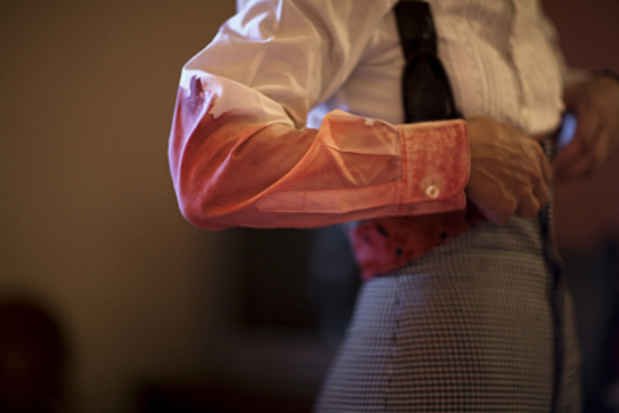Gina Levay "Bull Fight"
Hous Projects

This event has ended.
hous projects announces a solo exhibition at the New York gallery of Gina LeVay’s bullfight.
Bullfighting is the only art in which the artist is in danger of death and in which the degree of brilliance in the performance is left to the fighter's honor. – Ernest Hemingway
There are only three sports: bullfighting, motor racing, and mountaineering; all the rest are merely games. - Ernest Hemingway
Bullfighting has intrigued artists since its inception. Goya, Picasso and Hemingway in particular were driven to the point of obsessiveness to capture the nuances of this tradition riddled with symbolism and conflict. As a pillar of the Spanish culture, bullfighting showcases heroism, gender roles, fashion, celebrity, religion, ritual, sacrifice, sex, honor, performance art and sport. In the ring, bullfighters strive towards a goal, which is not simply a title. They literally take their lives to the line and hope to leave the ring not only alive, but also unscathed. It is not just physical technique and skill that are required to be able to step into the ring; it is necessary to be mentally prepared and fearless. Otherwise, the bull has the advantage and there is no margin of leniency you want to extend to the bull as you tease and taunt him with your flashing cape and your crew corrals him as needed. Historically this daring was left to the men, but recently a handful of women have challenged tradition and embraced the bullfight as both artists and athletes.
Five years ago, Gina LeVay embarked on an exploration of these female matadors, or las toreras. In her journey, she has had the opportunity to record Marie Paz Vega, Raquel Sanchez, Sandra Moscoso, Lupita Lopez, Melina Parra and the exceptional Marie Sara who enters the ring as a picador using a lance while on horseback which is a rare practice in current bullfighting. Through documenting the women’s lifestyles in and out of the ring, she examines the conflict of the female in the midst of a male dominated art and sport steeped in cultural mores. The female matador has faced much opposition in entering the ring, but LeVay is bringing their strengths and abilities to light. She aims to illuminate the truth of the bullfight for these women by capturing the diametrically opposed elements of brutality and sensuality, drama and harmony that are inherent in this dance of death. Her vibrant images reveal the dynamics of the fight, details of texture and the grit it takes for these women to conquer in the ring and in their daily lives.
The layers of the experience of a bullfight for the matador and the audience are complex. We tend to associate it is a male centric sport of man vs. beast, but on closer examination it is fraught with portrayals of the universal human condition. In an interview regarding the symbolism of bullfighting, Paco Pereda (a professor at San Sebastian University, Spain) iterates, “The most important thing isn’t in just killing the bull, but in how one kills it. And it’s the same with human experience. The most profound thing is how we live out our conflicts and problems…Blind animal instinct comes up against strategy and intelligence, which together is human nature. The bullfighter has to overcome his own animal nature, his own impulse to escape danger and run. So he fights, swoops the cape, adds a personal aesthetic, portrays an intelligence and bravery we hadn’t seen before. And, most importantly, he must make the bull “dance” to his rhythm.” He goes on to conclude that the bullfighter as an artist must understand the delicate balance of when to be aggressive and when to hold back to maintain the fine balance between life and death in the ring. This delicacy in style is what ultimately defines a bullfighter - male or female.
In her documentation of the subject, LeVay captures this grace, elegance and gumption of the women. She maximizes their stories with strong compositions marked by a soft light that is infused with brightness and clarity. Most striking is the concentration and poise LeVay shows in their eyes and body language. The work captures all the subtleties and subtext of their craft. For example, in the piece Despues, we see the crisp white shirt of a las toreras post fight. Blood fades from deep red to lightest pink as it travels in and out of the folds of her sleeve. The evidence is of a battle that is both gory and gorgeous. LeVay captures this detail and moment outside of the ring and in so doing speaks in one frame of the vigor, relief, training, valor and tragedy these women confront in pursuing their passion.
As Hemingway asserted, the matador "must have a spiritual enjoyment of the moment of killing…Once you accept the rule of death, thou shalt not kill is an easily and naturally obeyed commandment. But when a man is still in rebellion against death, he has pleasure in taking to himself one of the Godlike attributes, that of giving it. This is one of the most profound feelings in those men who enjoy killing. These things are done in pride and pride, of course, is a Christian sin and a pagan virtue. But it is pride which makes the bull-fight and true enjoyment of killing which makes the great matador."
Media
Schedule
from April 28, 2011 to June 25, 2011
Opening Reception on 2011-05-05 from 19:00 to 21:00